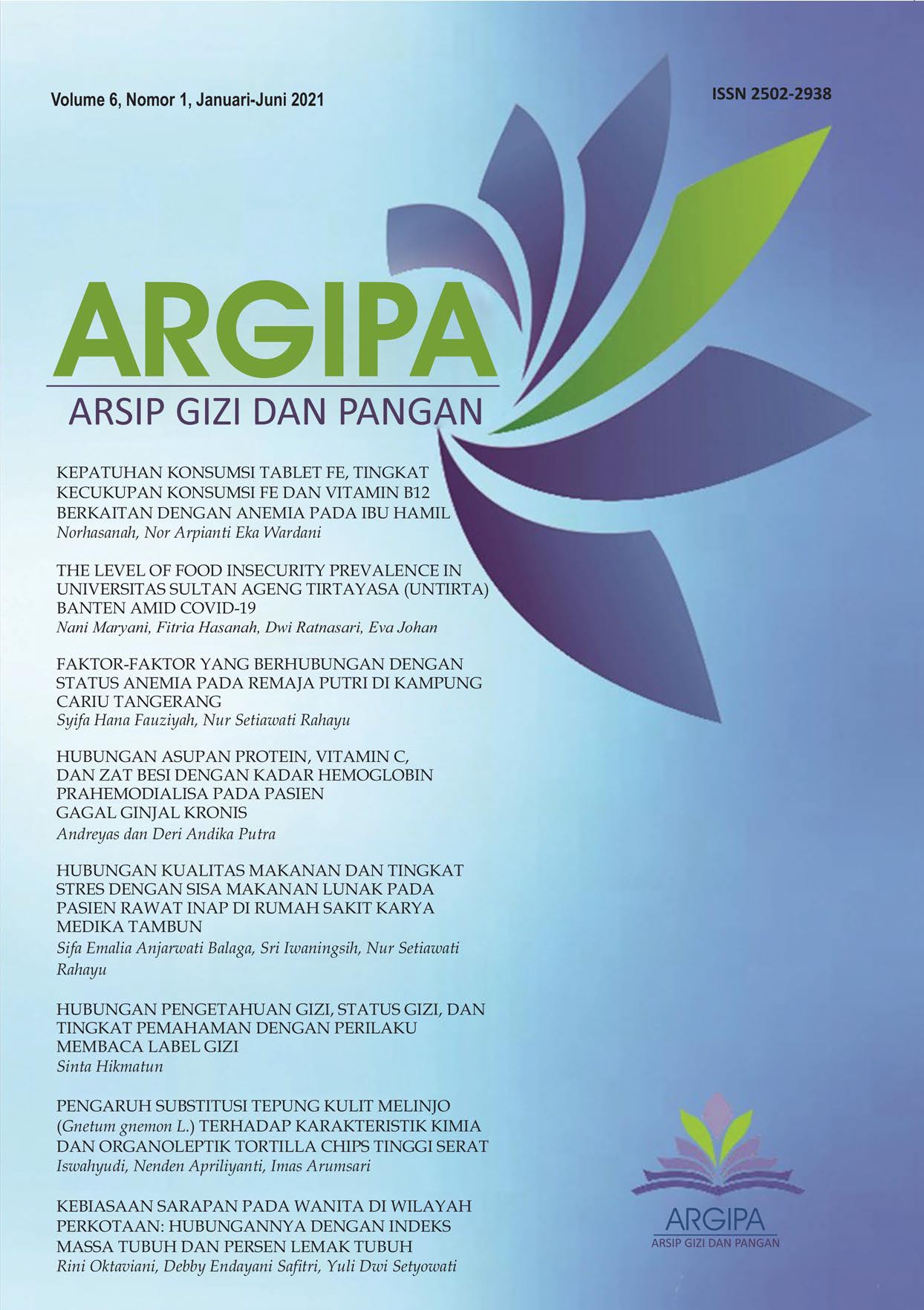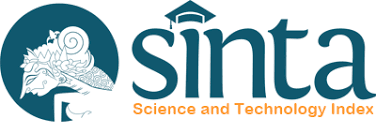The relationship of nutrition knowledge, nutrition status, and level of understanding with the behavior of reading nutrition labels
DOI:
https://doi.org/10.22236/argipa.v6i1.6196Keywords:
nutrition label, Reading Behavior, Nutritional Knowledge, Nutritional Status, Level of UnderstandingAbstract
The purpose of this study was to identify and to analyze the relationship between nutrition knowledge, nutrition status, and level of understanding with University Muhammadiyah Prof Dr Hamka (UHAMKA). This study used a cross-sectional method with total sample of 133 students. The results showed that there was a relationship between nutrition knowledge, nutrition status, and level of understanding with the behavior of reading nutrition labels. Further research is needed to examine other factors that can influence the behavior of reading nutrition labels.
Downloads
References
Anggraini, S., Handayani, D., & Kusumastuty, I. (2018). Tingkat Pengetahuan Cara Membaca Label Informasi Gizi Mahasiswa Status Gizi Normal Lebih Baik dibandingkan Mahasiswa Obesitas. Indonesian Journal of Human Nutrition, 5(2), 74-84.
Asgha, B. (2016). Analisis Penggunaan Label Informasi Nilai Gizi pada Produk Pangan Oleh Subjek di Kota Semarang. Buletin Studi Ekonomi, 21(2), 115-232.
Kemenkes RI. (2013). Riset Kesehatan Dasar (Riskesdas) 2013. Jakarta: Kementerian Kesehatan Republik Indonesia.
Benajiba, N., Mahrous, L., Bernstein, J., & Aboul-Enein, B. H. (2020). Food labeling use by consumers in Arab countries: a scoping review. Journal of Community Health, 45(3), 661-674.
Bonanno, A., Bimbo, F., Cleary, R., & Castellari, E. (2018). Food labels and adult BMI in Italy–an unconditional quantile regression approach. Food Policy, 74(issue C), 199-211.
Badan Perlindungan Konsumen Nasional. 2013. Hasil Kajian BPKN di Bidang Pangan Terkait Perlindungan Konsumen. Jakarta
Drichoutis, A. C., Lazaridis, P., & Nayga, R. M. (2006). Consumers' use of nutritional labels: a review of research studies and issues. Academy of Marketing Science Review, 9(9), 1-22.
Fatmaningtyas, H., & Andrias, D. R. (2016). Hubungan pengetahuan dan keterampilan dengan kepatuhan membaca label gizi makanan kemasan pada ibu balita di Kecamatan Rungkut, Surabaya. Jurnal Penelitian Kesehatan, 14(3).
Ha, N. M., & Dung, N. T. (2017). To study consumers' use of information on food labels in Vietnam. International Review of Management and Marketing, 7(1), 175-182.
Hassan, H. F., & Dimassi, H. (2017). Usage and understanding of food labels among L ebanese shoppers. International Journal of Consumer Studies, 41(5), 570-575.
Kim, S. D. (2018). Relationship between awareness and use of nutrition labels and obesity. Biomedical Research, 29(11), 2238-2242.
Liu, R., Hoefkens, C., & Verbeke, W. (2015). Chinese consumers' understanding and use of a food nutrition label and their determinants. Food Quality and Preference, 41, 103-111.
Loureiro, M. L., Yen, S. T., & Nayga, Jr, R. M. (2012). The effects of nutritional labels on obesity. Agricultural economics, 43(3), 333-342.
Mardiah, W., & Lumbantobing, V. B. (2020). Student knowledge in reading nutrient label information and types of packaging food consumed by nursing students. Media Keperawatan Indonesia, 3(2), 45-53.
Miller, L. M. S. & Cassady, D. L. (2015). The effects of nutrition knowledge on food label use. A review of the literature. Appetite, 92, 207-216.
Montazeri, B., Sharifinia, K., Hadian, H., Mohammadbagher, S., & Bazarkhak, S. (2013). The impact of attitude on consumer behavior. Universal Journal of Management and Social Sciences, 3(3), 72-77.
Moore, S. G., Donnelly, J. K., Jones, S., & Cade, J. E. (2018). Effect of educational interventions on understanding and use of nutrition labels: a systematic review. Nutrients, 10(10), 1432.
Nadhiroh, N. O. O. S. R. & Nindya, T. S. (2017). Jenis kelamin dan pengetahuan dengan kebiasaan membaca label informasi nilai gizi di kalangan mahasiswa. Adi Husada Nursing Journal, 2(2), 49-52.
Notoatmodjo, S. (2010). Promosi Kesehatan dan Ilmu perilaku kesehatan. Jakarta: Rineka Cipta.
Notoatmodjo, S. (2010). Metodologi penelitian kesehatan.
Nurhasanah, A. R. (2013). Hubungan Persepsi dan Perilaku Subjek di DKI Jakarta terhadap Label Gizi Pangan dengan Status Gizi dan Kesehatan. Skripsi. Bogor: Institut Pertanian Bogor.
Oktaviana, W. (2017). Hubungan antara Karakteristik Individu dan Pengetahuan Label Gizi dengan Membaca Label Gizi Produk Pangan Kemasan pada Subjek di 9 Supermarket Wilayah Kota Tangerang Selatan Tahun 2016. [Skripsi]. Jakarta: Fakultas Kedokteran dan Ilmu Kesehatan, UIN Syarif Hidayatullah.
Safitri, D. E., & Rahayu, N. S. (2018). The effect of food label literacy education on high school students' knowledge. ARGIPA (Arsip Gizi Dan Pangan), 3(2), 91-95.
Sinclair, S., Hammond, D., & Goodman, S. (2013). Sociodemographic differences in the comprehension of nutritional labels on food products. Journal of Nutrition Education and Behavior, 45(6), 767-772.
Sumarwan, U., Simanjuntak, M., & Yuliati, L. N. (2017). Meta-analysis study: reading behavior of food products label. Journal of Consumer Sciences, 2(2), 26-40.
Tallant, A. (2017). First-year college students increase food label–reading behaviors and improve food choices in a personal nutrition seminar course. American Journal of Health Education, 48(5), 331-337.
Verissimo, A. C., Barbosa, M. C. D. A., Almeida, N. A. V., Queiroz, A. C. C., Kelmann, R. G., & Silva, C. L. A. D. (2019). Association between the habit of reading food labels and health-related factors in elderly individuals of the community. Revista de Nutriçí£o, 32:e180207, 1-12.
Zahara, S. (2009). Hubungan Karakteristik Individu, Pengetahuan, dan Faktor Lain dengan Kepatuhan Membaca Label Informasi Nilai Gizi, Komposisi, dan Kedaluwarsa pada Mahasiswa FKM UI Depok Tahun 2009. [Skripsi]. Depok: Fakultas Kesehatan Masyarakat, Universitas Indonesia.
Zepeda, L., Sirieix, L., Pizarro, A., Corderre, F., & Rodier, F. (2013). A conceptual framework for analyzing consumers' food label preferences: an exploratory study of sustainability labels in France, Quebec, Spain and the US. International Journal of Consumer Studies, 37(6), 605-616.

















